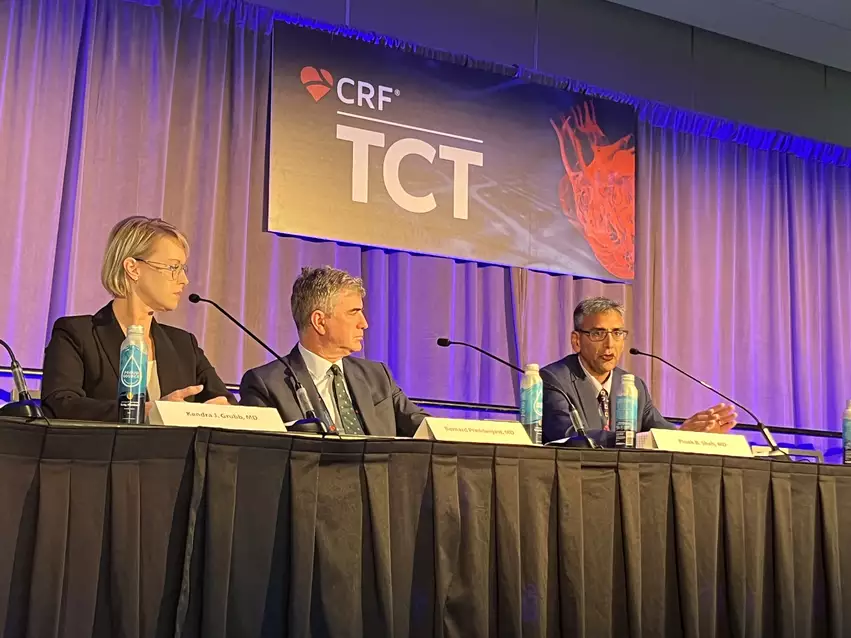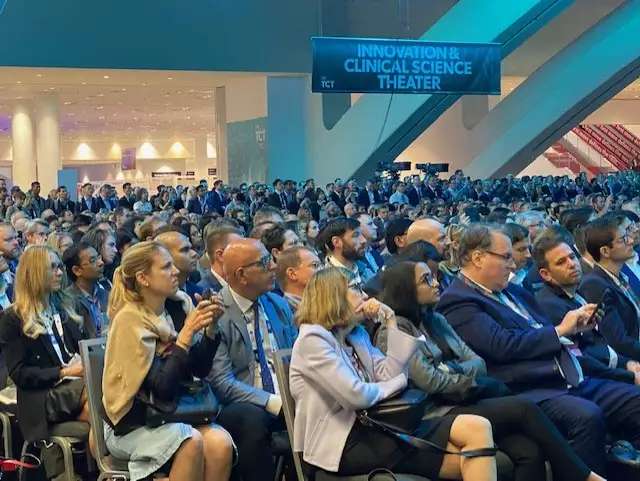PARTNER 3, Evolut and more: TAVR takes the spotlight in 4 late-breaking clinical trials at TCT 2023
Transcatheter aortic valve replacement (TAVR) has been one of the hottest topics in interventional cardiology for years now, and the large crowds at TCT 2023 in San Francisco suggest that will still be the case for many years to come.
The first four late-breaking clinical trials presented at the annual Transcatheter Cardiovascular Therapeutics conference all focused on ongoing developments in the world of TAVR. The presentations occurred Tuesday, Oct. 24, in front of a packed audience that was clearly anticipating the results of these studies.
PARTNER 3 trial
Martin B. Leon, MD, a longtime interventional cardiologist with the Columbia University Department of Medicine and a founder of the Cardiovascular Research Foundation, kicked off the festivities with five-year data from the PARTNER 3 trial, which compared outcomes after TAVR with the Sapien 3 valve from Edwards Lifesciences and surgical aortic valve replacement (SAVR) among low-risk patients. His team’s findings were simultaneously published in the New England Journal of Medicine.[1]
The analysis included 1,000 low-risk patients randomized to either TAVR or SAVR. Five-year follow-up was achieved in 94.6% of TAVR patients and 88.3% of SAVR patients.
The study’s primary endpoint was the non-hierarchical composite of all-cause death, all stroke or rehospitalization. After one year, TAVR was associated with a statistically significant advantage over SAVR. After five years, TAVR was still associated with improved outcomes compared to SAVR, but the difference was no longer statistically significant.
All in all, the researchers concluded that both treatment options—TAVR and SAVR—were associated with “similar and low clinical event rates,” including cardiovascular death rates of approximately 1% per year, stroke rates of approximately 1% per year and cardiovascular rehospitalization rates of approximately 3% per year.
Meanwhile, new-onset atrial fibrillation (AFib) was more common after surgery, and mild paravalvular leak was more common after SAVR.
Leon’s team ultimately concluded that TAVR with a Sapien 3 valve was a “meaningful alternative” to surgery for low-risk patients with severe, symptomatic aortic stenosis.
“We can tell our patients who have low-risk aortic stenosis that, for these two therapies, by the end of five years, there is more than a 70% chance they will be alive and feeling well with either no or very mild symptoms,” Leon explained. “We can also tell them that, at the end of five years, there is a more than 85% chance with either therapy that they will be alive with what would be a durable heart valve.”
Several thought leaders in the structural heart space discussed the PARTNER 3 findings during a TCT press conference. Bernard Prendergast, DM, an interventional cardiologist with Cleveland Clinic London, was "excited" about the results and said people have been anticipating this update for quite some time.
“I think it’s a win for our field,” added Pinak B. Shah, MD, director of the cardiac cath lab at Brigham and Women’s Hospital.
Evolut Low Risk
Michael J. Reardon, MD, a cardiovascular surgeon with Houston Methodist and a veteran TAVR researcher, took the stage next to present four-year data from the Evolut Low Risk trial, which examined patient outcomes among low-risk patients treated with either TAVR or SAVR. All TAVR patients were treated with an Evolut valve from Medtronic.
The analysis focused on 1,414 low-risk patients randomized to undergo treatment with TAVR or SAVR. The average age among these patients was 74 years old, and just 23% were under the age of 70 at the time of treatment. Overall, TAVR was linked to lower all-cause mortality and disabling stroke rates as well as improved hemodynamics.
While these outcomes have been consistent for four years now, Reardon said he is waiting until at least six- or seven-year data before he starts feeling confident about the long-term performance of these TAVR valves. He has been here in the past with other valves, he explained; patient outcomes often start to drop as time goes on.
Reardon also said that heart teams face a crucial decision when making the choice between TAVR and SAVR for a low-risk patient. Today’s cardiologists, he said, appear to be going with TAVR more frequently for younger patients who may be a better fit for surgery.
“Our guidelines still say that, if you’re less than 65 years old, you should have surgery,” he said during a TCT press conference. “You look at the data, some 46% are now having TAVR. We don’t know what that will mean.”
The full study was published in the Journal of the American College of Cardiology.[2]
WATCH-TAVR
Samir Kapadia, MD, a cardiologist with Cleveland Clinic, was next up with his presentation of the WATCH-TAVR trial, which examined the potential of performing TAVR and left atrial appendage occlusion (LAAO) with Boston Scientific’s Watchman device at the same time.
Kapadia noted that a significant percentage of TAVR patients go on to require treatment with a Watchman device later in life. His team evaluated the impact of performing these two procedures at the same time on aortic stenosis patients who also present with AFib.
WATCH-TAVR included data from 349 patients with both severe symptomatic aortic stenosis and AFib who were randomized to either undergo TAVR and LAAO at the same time or just TAVR and medical therapy. The study’s primary endpoint was a composite of the first occurrence of all-cause mortality, stroke or bleeding events after two years.
Overall, Kapadia et al. determined that performing TAVR and LAAO at the same time was non-inferior to TAVR and medical therapy. However, TAVR/LAAO patients did appear to face a heightened risk of arterial or venous thromboembolism.
Kapadia told the TCT audience that he could see a future where cardiac procedures are combined more frequently—assuming, of course, the patient is an appropriate candidate for both. Medicare reimbursement would need to be adjusted for this to be a realistic possibility, but Kapadia believes CMS could be open to making those changes as necessary.
Read the full analysis in Circulation.[3]
ALIGN-AR
The final late-breaking clinical trial of the day was presented by Vinod H. Thourani, MD, a cardiothoracic surgeon with Piedmont Healthcare. Thourani shared data from the ALIGN-AR trial, which examined the safety and effectiveness of JenaValve’s new-look Trilogy TAVR valve designed to treat high-risk patients with aortic regurgitation (AR).
A TAVR valve capable of treating severe AR represents an unmet need in interventional cardiology. Based on the results presented at TCT, the Trilogy system could be on its way to meeting that need. The valve was associated with an “excellent” performance and met the research team’s performance goals for both safety and efficacy. Thourani noted that the valve was linked to a higher rate of pacemaker implantations early on, but operators quickly realized that the valve was different from other TAVR valves and did not have to be pushed quite so deep. Once the necessary adjustment was made, Thourani said, pacemaker rates dropped across the board.
During the TCT press conference, Prendergast said he was “really excited” by these results.
“AR is a different disease than aortic stenosis,” he said. “The patients are different and the anatomies are different, so we need a different device. Using currently available TAVR devices off label to treat AR can be successful, but it is fraught with risks of embolism and other adverse consequences. I congratulate the JenaValve investigators because it has been a long journey for this valve.”
The Trilogy valve is not yet approved by the U.S. Food and Drug Administration.



